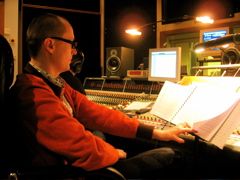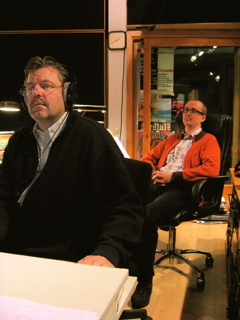Homepage > Documents > Musician Interview
Metropole Orkest musician interview with composer and arranger Vellu Halkosalmi
"Back to Basic Qualities"
An interview with composer/arranger Vellu Halkosalmi
Saturday, January 24, 2009. I meet Vellu Halkosalmi at the Metropole Orkest (MO) Studio in Hilversum where Gert Jan van den Dolder sits at the mixer panel to create the master tape with MO Big Band recordings of Vellu's works, earlier that week. The composer is willing to give us some insight into his creative work.
Background
Vellu Halkosalmi (Finland, 1971) started playing clarinet and trombone in a local village wind band. When this group dismantled in his teenage years, he turned to the electric guitar. Listening to cassette tapes of his rock heroes (AC/DC, heavy metal), trying to imitate the style, he developed his listening skills. His ear training enabled him to transcribe music from audio tapes, gradually moving towards blues and jazz music and larger orchestras.
He entered the Helsinki Jazz and Pop Conservatorium in 1991 as a rock and blues player. Hearing the Quincy Jones album This is How I Feel About Jazz (1957) was a turning point in his life; he got the jazz bite and was Inspired by big band music. He continued serious transcription work, e.g., the Quincy Jones band in Moaning, the Vince Mendoza arrangements for Joni Mitchell's Both Sides Now. By 1999, after graduating from the conservatorium, he was assigned the job of teaching music theory and ensemble playing, while developing his compositional technique.
His teacher at the conservatorium, and today still a friend and mentor, Kaj Backlund (former trumpet player and arranger in the UMO Jazz Orchestra) taught him invaluable tricks about the big band trade and told him: "If you want to make a living as composer/arranger, better be versatile and fast." Vellu took that advise seriously and started to develop writing skills. He characterises himself as: "I am not the most temporary guy. I love tradition; the music should never be hard to understand. But I am fast, really fast; I never spend more than two days on an arrangement. A deadline is for me the best inspiration."
Vellu Halkosalmi participated in the 2003 Metropole Orkest International Arrangers Workshop. Vellu about this event: "When the 9 days of the workshop were over and while I was on the train, I almost cried. It felt like I was allowed to drive a Mercedes luxury car and then it was taken away from me. Back home I decided to reiterate the experience and think big. I always liked the saxophone playing of Jukka Perko and had been transcribing his solos. So first I approached him with the idea to write a series of pieces for him and an orchestra. He was impressed by my transcriptions and approved. Then I collected my courage and sent an e-mail to Frits Bayens. Incredibly, but true, the answer came within an hour; I could have the whole MO for a week in 2005. That got me going. I wrote a set of pieces under the title Arctic Blues in 12 days composing and 4 weeks of arranging effort. From studying the MO CD's, I could identify solo spots for each section of the orchestra and soloists such as Bart van Lier, Ruud Breuls and Leo Janssen."
Recent work
After the 2005 MO project with Jukka Perko, Vellu Halkosalmi obviously carried on his creative work. In 2006 he was commissioned by the MO to do arrangements for a Gala Evening concert, for Cristina Branco and several other events.
His versatility took him to a project with Finnish rock singer Kauko Röyhkä, who describes himself as "anti-singer", on the verge of the punk repertoire. Vellu accepted the challenge of transferring the heavy groove of the songs to a 12-piece string orchestra (4+3+2+2+1); 70 minutes of music were completed in just 5 weeks, in a style that definitely is different from the conventional long notes harmonic string backgrounds in pop music. Vellu conducted the orchestra while touring around the country and also produced the album from that project. His writing skills for strings are partly based on his family experience: his wife playes the cello and Vellu has been studying the violin together with the eldest from his 3 children.
Folk music from his home country also was the inspiration for another project: 12 Finnish tango and folk tunes where re-arranged for Jukka Perko and the WDR Big Band in Cologne, Germany. Again, 90 minutes of music were completed within 6 weeks in September and October 2008. Vellu conducted the rehearsals and concert during the second half of October.
One month later he performed another project, now with a more classical instrumentation. After approaching the conductor of the Lappland Chamber Orchestra, the guitar player Teemu Viinikainen stepped onboard and Vellu started writing a 30 minute piece. He describes that work as: "A mix of classical and jazz music. I liked the pure, natural sound of the guitar; Teemu plays an original Gibson 175, with no effects. I strived for a groove in the chamber orchestra; remember, there is no rhythm section. The fact that the string section contained one bass player only, was a blessing. It allowed me to assign the rhythmic control to that single part. It was performed live in November 2008. I hope to add another 20 minutes or so to that piece, and record it in a studio later this year."
Technique and style
Vellu Halkosalmi is a traditional man in multiple respects. His tools are the pen and paper to jot down the compositions he hears in his head. His well-trained ear allows him to work fast. Only after the manuscript contains the full arrangement he turns to the computer. Vellu: "At the computer I work even faster, entering the score and extracting the parts. I do all the copying work myself and the musicians will have professional sheet music on their desks."
About his own personal style he reveals: "I love to write tunes; I aim for a melody or motive that anybody can whistle. I care about the form of a piece and development of those motives. Then, there must be a clear groove [Vellu demonstrates this by tapping hands and feet in complicated rock grooves], not only in the rhythm section, but also in the other instrumental parts. Obviously, I use jazz harmonies, with extended chords in thirds. However, I also apply chord structures in seconds and fourths; a nice example is a song I did in the Kauko Röyhkä project. I transferred the increasing intensity guitar and drum groove therein to a set of marcato clusters for strings; you will hear the five tones from a Dorian scale simultaneously. Then, another element in my style is what is known as the Quincy Jones 'Ear Candy'; I look for a characteristic orchestration effect in my work, a combination of instruments that will create a unique sound."
Current project
In the week of 19 to 24 January 2009, the Metropole Orkest Big Band (MOBB) recorded 7 pieces by Vellu Halkosalmi in their Hilversum studio. Two earlier pieces were prize-winning contributions to the Esko Linnavalli big band composition contest (Linnavalli was one of the founders and a long-time arranger/conductor of the UMO Jazz Orchestra); Kaiku is from 2005 and has been performed by many Finnish big bands, Solo Flight, written in its original form in an 18 hours hurry, has been re-arranged for this session.
The first newly written piece is Release. It is the longest piece (12-13 minutes) with an easy to hum motive, harmonies in seconds and fourths and a saxophone special chorus, about Vellu tells us: "Are you familiar with the Herb Pomeroy technique of `line writing'? Essentially, what it means is that you identify a number of marking points in the saxophone lead. Then you decide on the voicing of these highlights in the melody and finally you allow free voice movement in the section towards these points. Well, I sort of used that approach for the sax chorus in this piece; but obviously, it also has a lot of parallel stuff inside."
Another fresh composition is Doctor Swing, a tribute to Quincy Jones, with a clear bouncing swing groove. And then there are A Kind of Blues, which is being edited by Gert Jan den Dolder in the control room while we are doing the interview, Playground and the last piece is Heli (the first name of the composer's wife).
Conclusion
Vellu Halkosalmi leaves behind the impression of a highly-skilled, traditional craftsmen, who knows his trade, understands the mechanisms of writing for various instrumentations. He is pragmatic and loves big band tradition. He cherishes experiences such as the recent recording sessions with the MOBB in Hilversum. For the year 2008 has has been given a Finnish national grant to enable him to concentrate on writing music. The application for another year of support is under consideration; if the outcome of that decision is positive we may be expecting another outburst of creativity from this friendly composer who feels that he now has "found his personal style" and knows where he wants to go from here.



